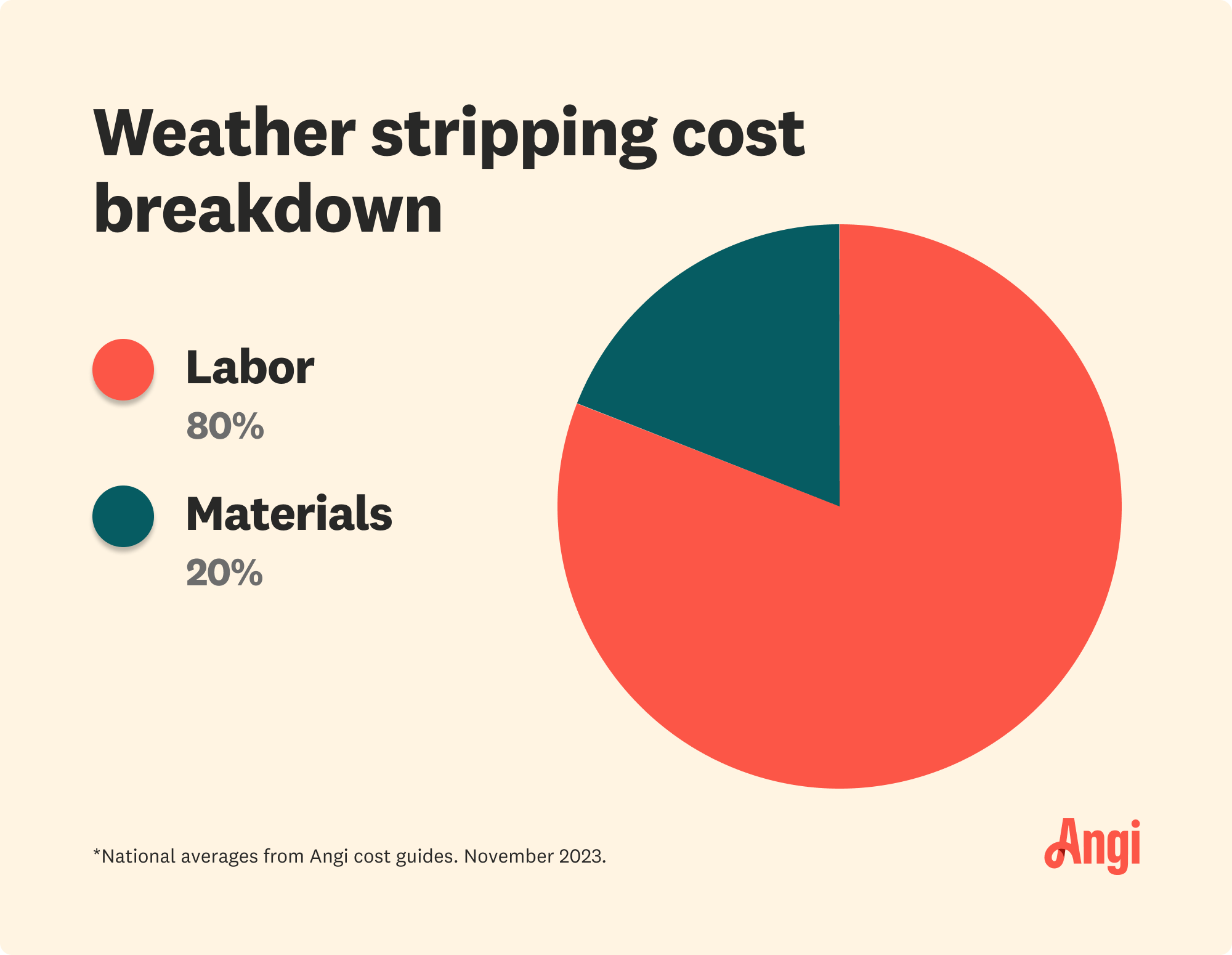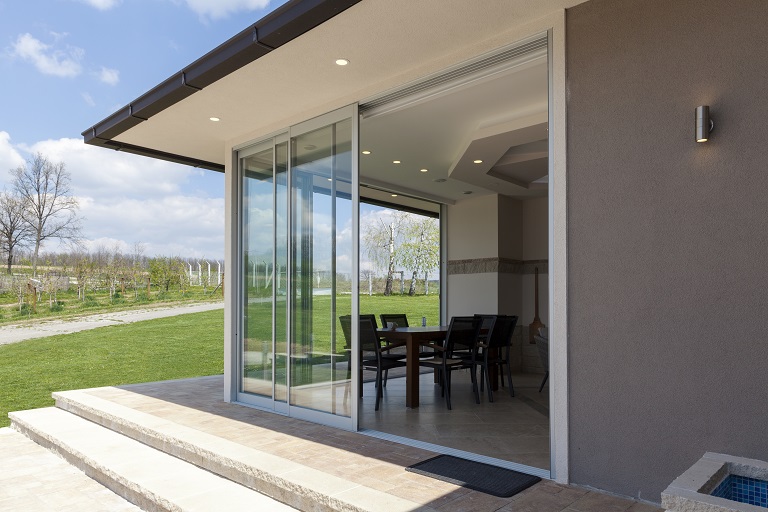
There’s nothing better than a dog door to give your pet free access to the outdoors. Use this dog door installation cost guide to see what it will cost you.
Door service costs depend on your project and location. Check with a local pro for your specific job.
The cost to weatherstrip a door varies depending on labor, materials, and the size or type of door.
Foam weatherstripping is the most affordable option at $0.16 to $0.25 per linear foot, while metal weatherstripping is the most expensive, costing $2 to $5 per linear foot.
Hiring a professional handyperson costs $50 to $150 per hour, ensures quality, durable results, and may be required for warranty purposes.
Weatherstripping a door improves energy efficiency and can reduce energy bills by 10% to 15% per year.
This article was created using automation technology and thoroughly fact-checked and edited by an Angi Editor in accordance with our AI policy.
The cost to weatherstrip a door averages $283, with an average range from $131 to $436. Prices vary based on material, door size, and labor. Homeowners may pay as little as $60 for basic DIY kits or up to $950 for premium materials and professional installation. Weatherstripping is usually priced per door, making it easy to estimate for multiple entries.
Understanding what affects the cost to weatherstrip a door helps you plan your project budget and get the most value. Let’s break down the main factors that impact your total investment.

There are several types of weatherstripping designed for doors, each with its own strengths. Adhesive-backed foam strips are budget-friendly and easy to install, great for interior doors or quick fixes. V-strips (or tension seals) are flexible and fit snugly in door jambs, balancing affordability and durability. Door sweeps attach to the bottom of the door, blocking drafts and debris. Tubular rubber and silicone seals offer a tight, long-lasting seal for exterior doors. Felt is inexpensive but less durable, while metal weatherstripping (such as bronze) offers premium performance and longevity.
Each type’s cost is influenced by its durability and suitability for specific door locations. For example, tubular rubber is ideal for harsh climates, while metal is best for long-term, heavy-use exterior doors.
| Weatherstripping Type | Average Cost per Door (Installed) | Best For |
|---|---|---|
| Adhesive-backed foam | $35–$80 | Interior doors, quick fixes |
| V-strip | $40–$90 | Exterior/interior, moderate durability |
| Door sweep | $45–$100 | Bottom seal for exterior doors |
| Tubular rubber | $50–$120 | Exterior doors, high durability |
| Felt | $30–$70 | Interior doors, low-traffic areas |
| Metal (bronze, etc.) | $100–$300 | Historic doors, premium applications |
The size and style of your door directly affect the amount of material needed and, in turn, the overall cost to weatherstrip a door. Standard single doors are most affordable, while oversized, double, or French doors require more materials and labor. Weatherstripping multiple doors at once can sometimes reduce the average cost per door, but custom-sized entries or unique designs may increase your total.
| Door Size/Type | Average Cost |
|---|---|
| Standard single | $35–$90 |
| Double | $60–$150 |
| French doors | $80–$200 |
| Sliding patio door | $60–$150 |
Material choice plays a big role in both the upfront and long-term cost to weatherstrip a door. Foam is cost-effective but less durable. Vinyl and rubber offer better longevity and weather resistance, making them good choices for exterior doors. Silicone is flexible and withstands extreme temperatures, while bronze and other metals are the most durable and attractive but come with a higher price.
Durable materials might cost more initially but require less frequent replacement, leading to savings over time.
| Material | Cost per Linear Foot |
|---|---|
| Foam | $0.16–$0.25 |
| Vinyl | $0.40–$0.80 |
| Rubber | $0.25–$0.50 |
| Silicone | $0.60–$1.20 |
| Bronze/Metal | $2–$5 |
| Felt | $0.25–$0.50 |
Labor costs are another significant component of the total cost to weatherstrip a door. Professional installation ranges from $50 to $150 per hour, depending on the installer’s experience and your location.
Handypeople or door specialists can handle this task. Complex projects, such as custom doors or historic homes, might require a specialist and additional time. Installing weatherstripping on multiple doors during a single visit can sometimes lower the per-door labor rate. Most standard installations take 30 minutes to one hour per door.
Proper preparation ensures a quality seal and can affect your final bill. Removing old weatherstripping, cleaning the frame, and addressing any minor door or frame damage are all part of the prep process. If your door is warped, misaligned, or part of a historic home, expect additional prep work and possible extra charges. Prep costs can range from $10 to $50 per door, depending on the condition and the amount of work required.
Tipping for weatherstripping professionals is not required but is always appreciated for excellent service. If you choose to tip, a standard amount is $10 to $20 per door or 10% of the total labor cost, especially if the job is complex or the pro goes above and beyond. For larger projects or multiple doors, consider a higher tip to reflect the extra effort.
Beyond materials and labor, a few other expenses can affect the cost to weatherstrip a door:
Removal and disposal of old weatherstripping, which may add $5 to $25 per door.
Door repairs, such as fixing gaps or adjusting hinges, range from $20 to $350 or more.
Upgrading or replacing door thresholds can add $40 to $150.
Adding door sweeps or bottom seals may cost $15 to $60 each.
Decorative or custom weatherstripping options, sometimes costing $25 to $100 extra.
Emergency or after-hours service fees, which can increase total costs by 20% or more.
Travel or minimum service charges for remote locations, averaging $25 to $50.
Sealing gaps and weatherstripping can save up to 20% in annual energy bills according to the U.S. Department of Energy.
Weatherstripping is a low-maintenance upgrade, but there are some ongoing costs and benefits to consider.
Properly maintained weatherstripping lasts longer and performs better. You’ll want to inspect it annually for wear, cracks, or gaps. Cleaning with mild soap and water helps prevent grime buildup. If any section is damaged, replacement costs run $10 to $40 per door, depending on the material. Most homeowners spend less than $20 per year on basic upkeep.
Weatherstripping a door does not create direct operating costs, but it leads to indirect savings. By sealing leaks, your heating and cooling systems work more efficiently, reducing energy bills. Well-weatherstripped doors can save 10% to 15% on annual energy costs, especially in older or drafty homes. Over several years, these savings can offset the initial installation cost.
Occasional repairs may be needed if the weatherstripping becomes loose, torn, or compressed. Repairing a small section can cost $10 to $30 in materials or $50 to $100 if you hire a pro. If drafts persist after repairs, it’s best to fully replace the weatherstripping for a better seal. Addressing issues early helps prevent bigger problems like water intrusion.
Weatherstripping a door does not affect standard homeowners' insurance, and no policy is required for this project. While some insurers offer discounts for overall energy efficiency improvements, weatherstripping alone rarely qualifies. However, in combination with other upgrades, it can contribute to a safer, more comfortable home.
Many homeowners consider whether to tackle weatherstripping themselves or call in a professional. The cost to weatherstrip a door on your own is usually limited to materials and a few basic tools. Most DIY kits range from $10 to $40 per door, and tools like scissors, a utility knife, or a screwdriver add $5 to $20 if you don’t already have them. Expect to spend one to two hours per door if you’re new to the process.
Hiring a pro means higher upfront costs but ensures a tight, long-lasting seal. Professional installation costs $75 to $200 per door on average, which covers both labor and materials. You’ll benefit from expert fit and finish, especially on tricky or custom doors. Professional jobs may also include warranties or guarantees for peace of mind.
Improperly installed weatherstripping can leave gaps, leading to energy loss, drafts, or even water intrusion. For complex doors, custom fits, or historic properties, it’s best to hire a pro.
| Approach | Material Cost | Tool Cost | Labor Time | Total Cost |
|---|---|---|---|---|
| DIY | $10–$40 | $5–$20 | 1–2 hours | $15–$60 per door |
| Pro | Included | Included | 30–60 min | $75–$200 per door |
You can further improve your door’s performance and comfort with a few common add-ons. Here are some additional services your pro can tackle and their average costs, including labor:
Door sweep installation: $75 to $150 per door, providing extra protection against drafts and pests.
Adding insulation to door frames or sidelights: $80 to $200, depending on complexity and materials.
Soundproofing enhancements: $150 to $500, such as acoustic seals or door gaskets.
Smart door seals or weatherstripping with integrated sensors: $50 to $200, for homes with advanced automation.
Removal and disposal of old weatherstripping: $20 to $50 per door.
These options can raise your upfront investment but deliver added energy savings, comfort, or style.
With a little planning, you can improve your home’s efficiency without overspending. Let’s look at some practical ways to keep your weatherstripping project affordable:
Choose durable materials to reduce replacement frequency.
Prep the door and frame yourself to save on labor.
Compare quotes from multiple local handypersons to compare pricing.
Schedule installation during off-peak seasons for better rates.
Maintain weatherstripping regularly to extend its lifespan.
Home is the most important place on earth, which is why Angi has helped more than 150 million homeowners transform their houses into homes they adore. To help homeowners with their next project, Angi provides readers with the most accurate cost data and upholds strict editorial standards. We extensively research project costs to develop the pricing data you see, so you can make the best decisions for you and your home. We rely on reputable sources, including the U.S. Bureau of Labor Statistics, academic journals, market studies, and interviews with industry experts—all to ensure our prices reflect real-world projects.
Want to help us improve our cost data? Send us a recent project quote to [email protected]. Quotes and personal information will not be shared publicly.
From average costs to expert advice, get all the answers you need to get your job done.

There’s nothing better than a dog door to give your pet free access to the outdoors. Use this dog door installation cost guide to see what it will cost you.

Sprucing up the barn or adding a rustic touch to your home? Use this guide to estimate barn door installation costs, so you can budget for your next project.

Door repairs cost around $250 on average but can range from $50 to $700 depending on the type of door, type of repair, materials, and project scope.

If you are wondering who to hire to install weather stripping on your door, we share the best experts for fixing those pesky air gaps.

Get expert insights on sliding glass door repair cost, including average prices, key cost factors, and tips to save money on your next repair project.

Making sure your doors aren’t hanging by a hinge is important. Here are some of the most common door problems to look out for and what causes them.